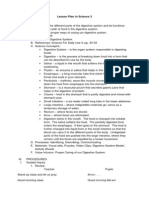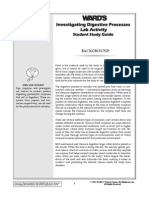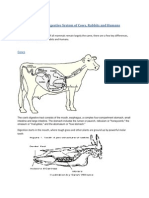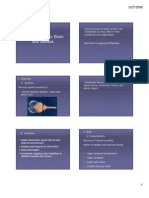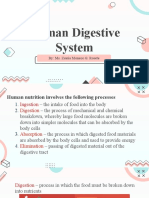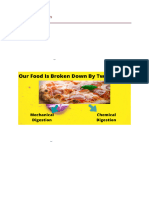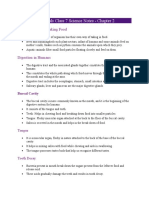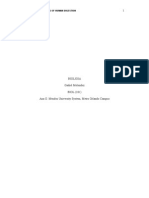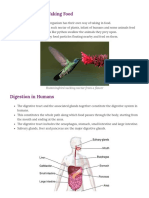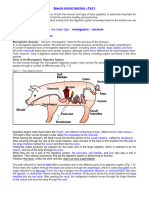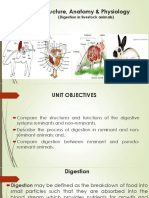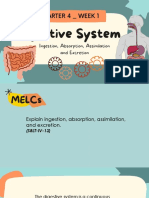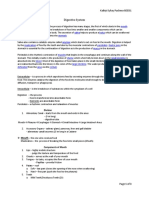Nonruminant Digestive Systems - Aves (Birds)
Nonruminant Digestive Systems - Aves (Birds)
Uploaded by
Wiwit Yuliyanti LestariCopyright:
Available Formats
Nonruminant Digestive Systems - Aves (Birds)
Nonruminant Digestive Systems - Aves (Birds)
Uploaded by
Wiwit Yuliyanti LestariOriginal Title
Copyright
Available Formats
Share this document
Did you find this document useful?
Is this content inappropriate?
Copyright:
Available Formats
Nonruminant Digestive Systems - Aves (Birds)
Nonruminant Digestive Systems - Aves (Birds)
Uploaded by
Wiwit Yuliyanti LestariCopyright:
Available Formats
Nonruminant Digestive Systems Aves (Birds)
Bird Digestive System
The Process of Digestion
1.
2.
beak tear food material into smaller particles. travel down the esophagus to the crop.
Bird Digestive System
The Process of Digestion 3. Birds will swallow small particles of gritty material (sand and small rock in the wild) and this grit collects in the crop. Birds utilize this grit to grind particles of food into smaller pieces. Water is also added to the food material in the crop.
Bird Digestive System
The Process of Digestion
Saliva mixes with the food in the mouth to begin breaking down simple carbohydrates into simple sugars. Amylases (enzymes that breakdown starch into sugars) found in saliva break certain chemical bonds to begin the process of carbohydrate digestion.
Bird Digestive System
The Process of Digestion
4.
Food then travels down the esophagus to the proventriculus, where it mixes with highly acidic gastric juices. The proventriculus acts similar to the stomach of other animals. Food material at this point has a mushy consistency.
Bird Digestive System
The Process of Digestion 5. Food material then moves to the gizzard, which is a very muscular organ
Food is physically ground into smaller pieces.
Bird Digestive System
The Process of Digestion Food material that leaves the proventriculus is called chyme. Chyme passes from the stomach to the first part of the small intestine, called the duodenum.
6.
Bird Digestive System
The Process of Digestion In the duodenum, the pancreas secretes enzymes that degrade sugars, fats, and proteins.
Bird Digestive System
The Process of Digestion
As chyme is moved through the duodenum, nutrients are absorbed into the bloodstream through small finger-like projections in the interior of the small intestine, called villi, as the nutrient-filled food mixture is squeezed by the peristalsis, making it more solid.
Bird Digestive System
The Process of Digestion
This process continues through the second part of the small intestine, called the jejunum. Chyme is continually compressed as it passed through the third part of the small intestine, called the ileum.
Bird Digestive System
The Process of Digestion 7. Chyme then moves into the large intestine, where moisture is continually removed by peristalsis.
Bird Digestive System
The Process of Digestion 8. Food material is then collected in the cloaca, and then is removed through the vent.
Bird Digestive System
You might also like
- Chapter 30 Homework Packet KeyDocument14 pagesChapter 30 Homework Packet Keyrosaroncero0% (4)
- Gastrointestinal System Disorders - MedSurg NursingDocument56 pagesGastrointestinal System Disorders - MedSurg NursingJermaine S. TeodoroNo ratings yet
- Tigers SensesDocument5 pagesTigers SensespaidalaNo ratings yet
- Care Sheet - Fat Tailed GeckoDocument2 pagesCare Sheet - Fat Tailed GeckoJohn GamesbyNo ratings yet
- Lesson Plan in Science 4 - LajieDocument10 pagesLesson Plan in Science 4 - LajieMar JenNo ratings yet
- Digestive System POGILDocument8 pagesDigestive System POGILLokesh BangaloreNo ratings yet
- Investigating Digestive ProcessesDocument12 pagesInvestigating Digestive ProcessesDiana Asatryan0% (1)
- Comparison of The Digestive System of CowsDocument3 pagesComparison of The Digestive System of CowsMatthew_Walker_746100% (1)
- Outdoor Hour Challenge 44 Rabbits and HaresDocument2 pagesOutdoor Hour Challenge 44 Rabbits and HaresBarbNo ratings yet
- Lecture 11. Avian Nervous SystemDocument6 pagesLecture 11. Avian Nervous SystemCube MaximNo ratings yet
- Iqra PPT (Autosaved)Document15 pagesIqra PPT (Autosaved)hira raoNo ratings yet
- Animal Adaptations UnitDocument86 pagesAnimal Adaptations Unitapi-224842598No ratings yet
- Vertebrates Birds, Reptiles, Amphibians, FishDocument17 pagesVertebrates Birds, Reptiles, Amphibians, FishcarmenbtNo ratings yet
- Digestive System PresentationDocument20 pagesDigestive System Presentationrocky2219No ratings yet
- 6th Class Digestive SystemDocument20 pages6th Class Digestive SystemJuvy MarquinezNo ratings yet
- Aquatic PlantsDocument1 pageAquatic PlantsJoana Marie BartonicoNo ratings yet
- Amphibians and Reptiles - Contents and Sample ChapterDocument25 pagesAmphibians and Reptiles - Contents and Sample ChapterPelagic Publishing100% (1)
- Classifying Vertebrates and InvertebratesDocument6 pagesClassifying Vertebrates and InvertebratesEliana CrespoNo ratings yet
- Circulatory SystemDocument8 pagesCirculatory SystemMary Eilleen CabralNo ratings yet
- Wildlife and HabitatsDocument13 pagesWildlife and HabitatsCaroline PollockNo ratings yet
- Care Sheet - Green IguanaDocument6 pagesCare Sheet - Green IguanaJohn GamesbyNo ratings yet
- How To Necropsy A MammalDocument40 pagesHow To Necropsy A MammalRoddy Hawianno RupelNo ratings yet
- Unit 3 Study Guide - TeacherDocument15 pagesUnit 3 Study Guide - Teacherapi-1986034770% (1)
- 11.1 Biodiversity ClassificationDocument22 pages11.1 Biodiversity ClassificationSyakirah AzmiNo ratings yet
- ECOSYSTEM For KidsDocument15 pagesECOSYSTEM For KidsLwin MgNo ratings yet
- Assist HatchesDocument52 pagesAssist Hatchesapi-237441301100% (1)
- BIRDS ActivityDocument13 pagesBIRDS ActivityMudasir SalikNo ratings yet
- Characteristics of ReptilesDocument2 pagesCharacteristics of ReptilesPatricia HariramaniNo ratings yet
- Classification of AnimalDocument12 pagesClassification of AnimalMustika Ayuni100% (1)
- Perch Dissection-1Document4 pagesPerch Dissection-1api-297841438100% (2)
- Pencernaan 2Document23 pagesPencernaan 2Hasna Nur FaridahNo ratings yet
- The Digestive SystemDocument19 pagesThe Digestive Systemianpoblete13No ratings yet
- Digestive System HandoutsDocument7 pagesDigestive System HandoutsClexandrea Dela Luz Corpuz100% (1)
- The Digestive SystemDocument19 pagesThe Digestive SystemRirin A SaputriNo ratings yet
- MUCLecture_2022_52142525Document10 pagesMUCLecture_2022_52142525zryanm88mustafaNo ratings yet
- Digestive SystemDocument48 pagesDigestive SystemAlyanna Marie CarilloNo ratings yet
- Digestive SystemDocument10 pagesDigestive Systemankuashoksingh8No ratings yet
- 09 DigestionDocument85 pages09 DigestionSumihar PasaribuNo ratings yet
- Nutrition in Animals (EditedDocument5 pagesNutrition in Animals (Editedfebinstr339No ratings yet
- Digestive SystemDocument8 pagesDigestive SystemBenedicta AnyaNo ratings yet
- Week FourDocument5 pagesWeek FourRegina OdukaNo ratings yet
- Nutrition in Animals Class 7 Science Notes - Chapter 2: Different Ways of Taking FoodDocument4 pagesNutrition in Animals Class 7 Science Notes - Chapter 2: Different Ways of Taking FoodVikrant Deshmukh100% (2)
- Digestive Systems: Extension of The External Environment Into The Animal's BodyDocument3 pagesDigestive Systems: Extension of The External Environment Into The Animal's Bodychideraangelg5fNo ratings yet
- SS2 Biology Lesson NoteDocument35 pagesSS2 Biology Lesson NoteGodswillNo ratings yet
- Digestive SystemDocument26 pagesDigestive SystemFrancisco D. AndaquigNo ratings yet
- Digestive System NotesDocument10 pagesDigestive System NotesSumit SinghNo ratings yet
- Week 1 - Digestive SystemDocument26 pagesWeek 1 - Digestive Systemlau dashNo ratings yet
- Animal NutritionDocument74 pagesAnimal NutritionfatimazesellederramaNo ratings yet
- Nutrition NotesDocument8 pagesNutrition NotesAbidan Patrick (COOL DUDE PRO)No ratings yet
- Lab Exercise No. 1 Digestive SystemDocument6 pagesLab Exercise No. 1 Digestive SystemTITO AND BABY'S VIDEO'SNo ratings yet
- Anatomy and PhysiologyDocument13 pagesAnatomy and Physiologydaculareyndel04No ratings yet
- Running Head: 1: The Process of Human DigestionDocument5 pagesRunning Head: 1: The Process of Human Digestiongmelendez2No ratings yet
- Science Reviewer 4thquarterDocument3 pagesScience Reviewer 4thquarterMarxzia Alexzia Geraldez OonNo ratings yet
- Digestive System Grade 10-11Document7 pagesDigestive System Grade 10-11Nandana Nayana KumaraNo ratings yet
- The Digestive SystemDocument3 pagesThe Digestive SystemLuz Dianne SoloriaNo ratings yet
- Nutrition in AnimalsDocument6 pagesNutrition in AnimalsRenuNo ratings yet
- NUTRITIONDocument11 pagesNUTRITIONRushana SadaqatNo ratings yet
- Nutrition in Animals NotesDocument6 pagesNutrition in Animals NotesMidhun Bhuvanesh.B 7ANo ratings yet
- SCIENCE 8 Wk. 1Document14 pagesSCIENCE 8 Wk. 1oreooomingNo ratings yet
- Digestive System, Educational PlatformDocument77 pagesDigestive System, Educational Platformluckytraders0511No ratings yet
- c11 Special Animal NutritionDocument14 pagesc11 Special Animal NutritionAlexandra AlexandraNo ratings yet
- LN Digestive SystemDocument6 pagesLN Digestive SystemCasey Dkaye MorrisNo ratings yet
- Structure, Anatomy and Physiology (New)Document18 pagesStructure, Anatomy and Physiology (New)Aliyah wrightNo ratings yet
- Organs of The Digestive SystemDocument28 pagesOrgans of The Digestive SystemMitch TiangeNo ratings yet
- The Digestive SystemDocument23 pagesThe Digestive SystemJenderal Yohanes100% (1)
- In Vitro in Vivo Correlation IMPORTANCE OF DISSOLUTION IN IVIVC PDFDocument5 pagesIn Vitro in Vivo Correlation IMPORTANCE OF DISSOLUTION IN IVIVC PDFMehmet ÖzdemirNo ratings yet
- FenieDocument32 pagesFenieLilacx ButterflyNo ratings yet
- Delhi Public School, Jammu SESSION-2024-25 Half Yearly Examination Sample Paper Class-X M.MARKS-80 Subject - Science Time-3Hrs General InstructionsDocument7 pagesDelhi Public School, Jammu SESSION-2024-25 Half Yearly Examination Sample Paper Class-X M.MARKS-80 Subject - Science Time-3Hrs General InstructionsManthan JajuNo ratings yet
- Digestive System Lab Report: IntroDocument13 pagesDigestive System Lab Report: Introapi-296594736No ratings yet
- Anatomi Sistem Digesti.1Document71 pagesAnatomi Sistem Digesti.1Izaz Fishal ShafaNo ratings yet
- The 8 Day Ultimate FastDocument12 pagesThe 8 Day Ultimate FastBrocke100% (3)
- By: Abduljabbar Hamid Jabbar: University of Baghdad-College of Medicine M. B. Ch. BDocument14 pagesBy: Abduljabbar Hamid Jabbar: University of Baghdad-College of Medicine M. B. Ch. BXena XenaNo ratings yet
- Bio CH9 Form 4Document17 pagesBio CH9 Form 4SHAR VINANo ratings yet
- The Digestive System Powerpoint 1227698045024899 8Document44 pagesThe Digestive System Powerpoint 1227698045024899 8SunnyReduNo ratings yet
- Digestive System Kaikiyi Sykay Pacheco BEED1Document3 pagesDigestive System Kaikiyi Sykay Pacheco BEED1Kaikiyi Sykay PachecoNo ratings yet
- Function of The Gall Bladder in SheepDocument13 pagesFunction of The Gall Bladder in SheepAlina Haidău100% (1)
- Chapter No 08 New CompleteDocument27 pagesChapter No 08 New CompleteGhulam Baqir MazariNo ratings yet
- Case Study FistulectomyDocument94 pagesCase Study FistulectomynycharlzNo ratings yet
- OBJECTIVES: List The Four Organic Nutrients Needed by The Human Body. Identify Foods Containing Each ofDocument12 pagesOBJECTIVES: List The Four Organic Nutrients Needed by The Human Body. Identify Foods Containing Each ofmary loise diane bravoNo ratings yet
- Nutrition and Diet TherapyDocument24 pagesNutrition and Diet TherapyKimberly Marie BayangNo ratings yet
- Reviewer in General Biology Ii - Long QuizDocument14 pagesReviewer in General Biology Ii - Long QuizBernardine Angela YanezaNo ratings yet
- NCMB 316 M1 Cu1Document23 pagesNCMB 316 M1 Cu1Maica Lectana100% (1)
- Science Reviewer - Digestive SystemDocument4 pagesScience Reviewer - Digestive SystemCarlieseNo ratings yet
- AP2 Lab11 Anatomy of Digestion SP21Document16 pagesAP2 Lab11 Anatomy of Digestion SP21chasek76icloud.comNo ratings yet
- 27.2 Human Systems I SEDocument29 pages27.2 Human Systems I SEammarahmer321No ratings yet
- Cheat Sheet ExamsDocument5 pagesCheat Sheet ExamsSwe LayNo ratings yet
- Lecture-4 The Small IntestineDocument3 pagesLecture-4 The Small Intestineمرتضى حسين عبدNo ratings yet
- CH 03Document26 pagesCH 03asmaa aldraiwieshNo ratings yet
- M1 Q4 Science-8Document17 pagesM1 Q4 Science-8Jean Marie Vianney GuditoNo ratings yet
- Effects of Yoga On Digestive SystemDocument54 pagesEffects of Yoga On Digestive SystemManish Nahar33% (3)




